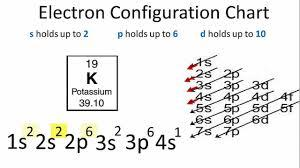
The electron configuration for Potassium in the ground state:
(A)- $1{{s}^{2}}2{{s}^{2}}2{{p}^{6}}3{{s}^{2}}3{{p}^{6}}$
(B)- $1{{s}^{2}}2{{s}^{2}}2{{p}^{6}}3{{s}^{2}}3{{p}^{6}}4{{s}^{2}}$
(C)- $1{{s}^{2}}2{{s}^{2}}2{{p}^{6}}3{{s}^{2}}3{{p}^{6}}4{{s}^{1}}$
(D)- $1{{s}^{2}}$
(E)- $1{{s}^{2}}2{{s}^{2}}2{{p}^{6}}3{{p}^{1}}$
Answer
127.2k+ views
Hint: Potassium in the ground state has 19 electrons and the shell structure is 2,8,8,1. To fill electrons in the orbitals there are some rules we must keep in mind namely Hund’s rule and Aufbau principle.
Complete step by step solution:
> In order to write the Potassium electron configuration we first need to know the number of electrons for the K atom. When we write the configuration we'll put all 19 electrons in orbitals around the nucleus of the Potassium atom.
> We need to distribute 19 electrons, knowing that there can be
- 2 in an s-orbital
- 6 in a p-orbital (2 in ${{p}_{x}}$, 2 in ${{p}_{y}}$ and 2 in ${{p}_{z}}$)
- 10 in a d-orbital
> We won’t need f-orbitals before atomic number 58.
The energy of an electron in a single electron atom can be determined by the principal quantum number. Thus, the order of increase in energy of various orbitals is given as, 1s < 2s = 2p < 3s = 3p = 3d <4s = 4p = 4d= 4f. But a multiple electron system (n+l) rule involving principal and azimuthal quantum numbers is followed although we do not need to apply it here.
> In writing the electron configuration for Potassium the first two electrons will go in the 1s orbital. Since 1s can only hold two electrons the next 2 electrons for Potassium go in the 2s orbital.
> The next six electrons will go in the 2p orbital. The p orbital can hold up to six electrons. We'll put six in the 2p orbital and then put the next two electrons in the 3s.
Since the 3s are now full we'll move to the 3p where we'll place the next six electrons.
We now shift to the 4s orbital where we place the remaining electron.

Therefore the Potassium electron configuration will be $1{{s}^{2}}2{{s}^{2}}2{{p}^{6}}3{{s}^{2}}3{{p}^{6}}4{{s}^{1}}$.
Hence, Option C is the correct answer.
Note: The electronic configuration provides an easy way for scientists to understand how electrons are arranged around the nucleus of an atom. This makes it easier to predict how atoms will interact to form chemical bonds.
Complete step by step solution:
> In order to write the Potassium electron configuration we first need to know the number of electrons for the K atom. When we write the configuration we'll put all 19 electrons in orbitals around the nucleus of the Potassium atom.
> We need to distribute 19 electrons, knowing that there can be
- 2 in an s-orbital
- 6 in a p-orbital (2 in ${{p}_{x}}$, 2 in ${{p}_{y}}$ and 2 in ${{p}_{z}}$)
- 10 in a d-orbital
> We won’t need f-orbitals before atomic number 58.
The energy of an electron in a single electron atom can be determined by the principal quantum number. Thus, the order of increase in energy of various orbitals is given as, 1s < 2s = 2p < 3s = 3p = 3d <4s = 4p = 4d= 4f. But a multiple electron system (n+l) rule involving principal and azimuthal quantum numbers is followed although we do not need to apply it here.
> In writing the electron configuration for Potassium the first two electrons will go in the 1s orbital. Since 1s can only hold two electrons the next 2 electrons for Potassium go in the 2s orbital.
> The next six electrons will go in the 2p orbital. The p orbital can hold up to six electrons. We'll put six in the 2p orbital and then put the next two electrons in the 3s.
Since the 3s are now full we'll move to the 3p where we'll place the next six electrons.
We now shift to the 4s orbital where we place the remaining electron.

Therefore the Potassium electron configuration will be $1{{s}^{2}}2{{s}^{2}}2{{p}^{6}}3{{s}^{2}}3{{p}^{6}}4{{s}^{1}}$.
Hence, Option C is the correct answer.
Note: The electronic configuration provides an easy way for scientists to understand how electrons are arranged around the nucleus of an atom. This makes it easier to predict how atoms will interact to form chemical bonds.
Recently Updated Pages
JEE Main 2025 - Session 2 Registration Open | Exam Dates, Answer Key, PDF

JEE Main 2023 (January 30th Shift 2) Maths Question Paper with Answer Key

Know The Difference Between Fluid And Liquid

JEE Main 2022 (July 25th Shift 2) Physics Question Paper with Answer Key

Classification of Elements and Periodicity in Properties Chapter For JEE Main Chemistry

JEE Main 2023 (January 25th Shift 1) Maths Question Paper with Answer Key

Trending doubts
JEE Main Login 2045: Step-by-Step Instructions and Details

JEE Main Exam Marking Scheme: Detailed Breakdown of Marks and Negative Marking

JEE Main 2023 January 24 Shift 2 Question Paper with Answer Keys & Solutions

JEE Main Participating Colleges 2024 - A Complete List of Top Colleges

JEE Main Course 2025: Get All the Relevant Details

Total number of lone pair electrons in I3 ion is A class 11 chemistry JEE_Main

Other Pages
JEE Advanced 2025: Dates, Registration, Syllabus, Eligibility Criteria and More

JEE Main Chemistry Question Paper with Answer Keys and Solutions

Learn About Angle Of Deviation In Prism: JEE Main Physics 2025

Degree of Dissociation and Its Formula With Solved Example for JEE

Physics Average Value and RMS Value JEE Main 2025

What is the significance of the Heisenberg uncertainty class 11 chemistry JEE_Main




